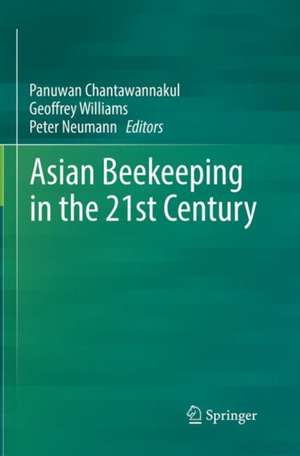Asian Beekeeping in the 21st Century
Editat de Panuwan Chantawannakul, Geoffrey Williams, Peter Neumannen Limba Engleză Paperback – 2 ian 2019
management of Asia, with a special focus on honey bees.
Asia is home to at least nine honey bee species, including the introduced European honey
bee, Apis mellifera. Although A. mellifera and the native Asian honey bee, Apis cerana,
are the most commonly employed species for commercial beekeeping, the remaining
non-managed native honey bee species have important ecological and economic roles
on the continent. Species distributions of most honey bee species overlap in Southeast
Asia, thus promoting the potential for interspecies transmission of pests and parasites,
as well as their spread to other parts of the world by human translocation.
Losses of managed A. mellifera colonies is of great concern around the world, including
in Asia. Such global colony losses are believed to be caused, in part, by pests and
parasites originating from Asia such as the mite Varroa destructor, the microsporidian
Nosema ceranae, and several bee viruses.
Taking advantage of the experience of leading regional bee researchers, this book provides
insight into the current situation of bees and bee management in Asia. Recent
introductions of honey bee parasites of Asian origin to other parts of the world ensures
that the contents of this book are broadly relevant to bee scientists, researchers, government offi cials, and the general public around the world.
Preț: 585.59 lei
Preț vechi: 770.50 lei
-24% Nou
Puncte Express: 878
Preț estimativ în valută:
112.05€ • 116.99$ • 92.74£
112.05€ • 116.99$ • 92.74£
Carte tipărită la comandă
Livrare economică 01-07 aprilie
Preluare comenzi: 021 569.72.76
Specificații
ISBN-13: 9789811340963
ISBN-10: 981134096X
Pagini: 325
Ilustrații: VIII, 325 p. 73 illus., 63 illus. in color.
Dimensiuni: 155 x 235 mm
Ediția:Softcover reprint of the original 1st ed. 2018
Editura: Springer Nature Singapore
Colecția Springer
Locul publicării:Singapore, Singapore
ISBN-10: 981134096X
Pagini: 325
Ilustrații: VIII, 325 p. 73 illus., 63 illus. in color.
Dimensiuni: 155 x 235 mm
Ediția:Softcover reprint of the original 1st ed. 2018
Editura: Springer Nature Singapore
Colecția Springer
Locul publicării:Singapore, Singapore
Cuprins
2.1 Introduction: The overview of honey bee diversity in Asia and bee health.- 2.2 Beekeeping in Turkey The Last Point of Asia towards Europe.- 2.3 Beekeeping in Parts of The Levant Region.- 2.4 Beekeeping History and Current Situation in Israel.- 2.5 Beekeeping and Honey Hunting in Nepal: Current Status and Future Perspectives.- 2.6 Beekeeping in India.- 2.7 Beekeeping in mainland, China.- 2.8 Beekeeping in Taiwan, China.- 2.9 Beekeeping in Russia.- 2.10 Beekeeping in Korea; Past, Current and Future Challenge.- 2.11 Beekeeping in Mongolia.- 2.12 Beekeeping in Japan.- 2.13 Development of beekeeping in Laos: various strategic choices.- 2.14 Beekeeping in Vietnam.- 2.15 Beekeeping in Thailand.- 2.16 Social bees and current status of beekeeping in Indonesia.- 2.17 Bee diversity in the Philippines and current status of beekeeping.- 2.18 Future perspectives.
Notă biografică
Panuwan Chantawannakul (Faculty of Science, Chiang Mai University, Thailand)
Geoffrey Williams (Department of Entomology & Plant Pathology, Auburn University, USA)
Peter Neumann (Inst. of Bee Health, University of Bern, Switzerland)
Textul de pe ultima copertă
This book provides insights to readers by local researchers on current bee diversity, bee flora, history of beekeeping, development of modern beekeeping and drawbacks especially bee diseases and parasite in different geographical areas in Asia.
Asia is home to at least nine honey bee species, including the introduced European honey bee, Apis mellifera. Although the introduced European honey bee and the native Asian honey bee, Apis cerana, are the most commonly employed species for commercial beekeeping, the remaining non-managed native species have important ecological and economic roles on the continent. Species distributions of most honey bee species overlap in Southeast Asia, promoting the potential for interspecies transmission of pests and parasites, as well as their spread to other parts of the world by human translocation. The decline of honey bee populations is of great concern around the world, including Asia. Global colony losses of European honey beesare believed to be caused, in part, by pests and parasites originating from Asia such as the mite Varroa destructor, the microsporidian Nosema ceranae, and several bee viruses. Using the experiences of leading Asian bee researchers, this book provides insight to readers about bee diversity, flora, management, and stressors in Asia, with a special focus on honey bees.
Bee scientists, researchers, government officer and general audience who have interests in beekeeping especially in Asia will find this an important account.
Asia is home to at least nine honey bee species, including the introduced European honey bee, Apis mellifera. Although the introduced European honey bee and the native Asian honey bee, Apis cerana, are the most commonly employed species for commercial beekeeping, the remaining non-managed native species have important ecological and economic roles on the continent. Species distributions of most honey bee species overlap in Southeast Asia, promoting the potential for interspecies transmission of pests and parasites, as well as their spread to other parts of the world by human translocation. The decline of honey bee populations is of great concern around the world, including Asia. Global colony losses of European honey beesare believed to be caused, in part, by pests and parasites originating from Asia such as the mite Varroa destructor, the microsporidian Nosema ceranae, and several bee viruses. Using the experiences of leading Asian bee researchers, this book provides insight to readers about bee diversity, flora, management, and stressors in Asia, with a special focus on honey bees.
Bee scientists, researchers, government officer and general audience who have interests in beekeeping especially in Asia will find this an important account.
Caracteristici
Insights from local scientists/experts and bee researchers, who worked on bee heath, local & traditional knowledge, beekeeping techniques in their countries which are not available in published articles Provides new and up-to-date information on detailed beekeeping practice and distribution of bee pests and pathogens One book covering all bee species and beekeeping practices in Asia for the world
